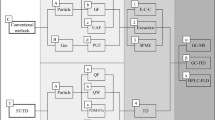Summary
Representative concentrations of volatile halocarbons in ambient air are determined by automated, repetitive sampling with sorbent-packed traps, followed by on-line thermodesorption, stationary-phase focussing, capillary gas chromatography, and electron-capture detection. Cryogenic enrichment and the associated problem of water-collection are avoided by ambient trapping using micro-traps packed with organic polymer- and carbon molecular-sieve sorbents. Under optimization of flow conditions and by use of thick-film capillaries, components with boiling points even below ambient temperature can be analyzed on-line by capillary gas chromatography, without the need for cryogenic peak focussing during injection. Data storage, quantification, statistical evaluation, and graphics generation are performed with commercial software programs. The instrumentation can be adapted for monitoring chemically stable volatile trace components with low and medium polarity. The results obtained with the instrumentation show that atmospheric levels of the major C1/C2-halocarbons may fluctuate over short time intervals; therefore, several hundred values must be accumulated for comparison of air pollutant burdens at different locations.
Similar content being viewed by others
References
Molina MJ, Rowland FS (1974) Nature 249:810–812
Wang WC, Yung YL, Lacis AA, Mo T, Hansen JE (1976) Nature 194:685–690
Frank H (1991) Ambio, in press
Wallace LA (1987) The total exposure assessment methodology (TEAM) study. EPA, Washington DC
Georgopoulos PG, Seinfeld JH (1982) Environ Sci Technol 16:401A-416A
Frank W, Frank H (1990) Atmos Environ 24A:1735–1739
Bauer U (1981) Zbl Bakt Hyg I Abt Orig B 174:200–237
Kirschmer P, Ballschmiter K (1983) Int J Environ Anal Chem 14:275–284
Reineke FJ, Bächmann K (1985) J Chromatogr 323:323–329
Müller S, Oehme M (1990) J High Resol Chromatogr 13:34–39
Phillips JB, Valentin JR, Carle GC (1982) ASTM Special Technical Publication 786:135–141
Frank W, Frank H (1990) Chromatographia 29:571–574
Grob K, Artho A, Frauenfelder C, Roth I (1990) J High Resol Chromatogr 13:257–260
Grob K, Grob GJ (1983) J High Resol Chromatogr 6:133–139
Abramovitz M, Stegun IA (eds) (1984) Pocket book of mathematical functions. Harri Deutsch, Thun Frankfurt/Main
Lillian D, Singh HB, Appleby A, Lobban LA (1976) J Environ Sci Health A11:687–710
Simmonds PG (1981) J Chromatogr Libr 20:255–274
Prinn RG, Simmonds PG, Rasmussen RA, Rosen RD, Alyea FN, Cardelino CA, Crawford AJ, Cunnold DM, Fraser PJ, Lovelock JE (1983) J Geophys Res 88:8353–8367
Frank H, Dürk H (1983) Arch Toxicol 53:213–223
Kirschmer P, Ballschmiter K (1983) Int J Environ Anal Chem 14:275–284
Rudolph J, Ehhalt DH, Khedim A, Jebsen C (1981) J Chromatogr 217:301–310
Jeltes R, Burghardt E (1972) Atmos Environ 6:793–805
D'Ottavio TW, Goodrich RW, Dietz RN (1986) Environ Sci Technol 20:100–104
Persson KA, Berg S (1989) Chromatographia 27:55–59
McClenny WA, Pleil JD, Holdren MW, Smith RN (1984) Anal Chem 56:2947–2951
Noy T, Fabian B, Borchers R, Janssen F, Cramers C, Rijks J (1987) J Chromatogr 393:343–356
Figge K, Rabel W, Wieck A (1987) Fresenius Z Anal Chem 327:261–278
Raymond A, Guichon G (1975) J Chromatogr Sci 13:173–177
Senum GI (1981) Environ Sci Technol 15:1073–1075
Huber JFK, Lauer HH, Poppe H (1975) J Chromatogr 112:377–388
Cramers CA, Rijks J, Bocek P (1972) J Chromatogr 65:29–37
Appleby A, Kazazis J, Lillian D, Singh HB (1976) J Environ Sci Health A11:711–715
Boyce SD, Hornig JF (1983) Water Res 17:685–697
Author information
Authors and Affiliations
Additional information
Dedicated to J. F. K. Huber on the occasion of his 65th birthday
Rights and permissions
About this article
Cite this article
Frank, H., Frank, W., Neves, H.J.C. et al. Automated trace analysis of airborne C1- and C2-halocarbons. Fresenius J Anal Chem 340, 678–683 (1991). https://doi.org/10.1007/BF00321534
Received:
Revised:
Issue Date:
DOI: https://doi.org/10.1007/BF00321534




